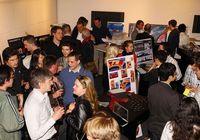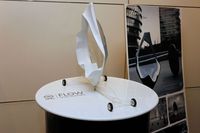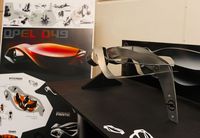RCA Students Unveil Vehicle Designs of the Future
LONDON/RÜSSELSHEIM – May 7, 2009: In celebration of the 40th year of the UK’s Royal College of Art (RCA) Vehicle Design course, a competition for students has reached its climax with three students on their way to Rüsselsheim following an evening of presentations to an assembled audience at the London Transport Museum. Their task: Design what the future of Opel/Vauxhall mobility might look like in 40 years.
Some 19 students from 11 countries, including Germany, the UK, the Czech Republic and China participated in the challenge and students had to identify the potential customer of tomorrow and use this profile to develop a vision of how the Opel/Vauxhall brand could play a role in the customer’s life. Ideas included zero-emission single seat vehicles; a racing vehicle driven by the human brain; eco-touring machines powered by waterfalls and city transport run on magnetic levitation.
Augustin Barbot (25) from France was chosen as overall winner by the judges: Vehicle Design Course Director Professor Dale Harrow as well as tutors Sam Livingstone and Richard Winsor, Mark Adams, Vice President of Design at GM Europe, Anthony Lo, Director of Advanced Design at GM Europe and Peter Stevens, an experienced independent car designer and part-time tutor.
Augustin’s concept was of Opel D49 or Darwin 2049 – a new breed of vehicle which has no wheels. It moves 10cms above the ground by electro-magnetic power or in the sea like a submarine. The three turbines, two at the front and one at the back, produce the energy to move the lightweight vehicle forward. With an aluminium frame covered by a semi-flexible and clear waterproof resin, there’s no need for body panels as the frame becomes an essential part of the design.
As his prize, Augustin will spend three months working at General Motors European Design Centre in Rüsselsheim and gain valuable work experience and insight through hands-on experience with future technologies such as electric vehicles.
Highly commended were Hyunjoon Park (25) from South Korea and Miika Heikkinen (26) from Finland. Recognising their efforts, General Motors has invited them both to Rüsselsheim to meet the GM Design Team so they can see how car designers work on a daily basis and see first hand how future mobility needs are shaped.
Hyunjoon’s concept was based around the idea of escaping the stresses and strains of the world through a new body shape that moulds to the drivers shape and their mood allowing human and car to become one.
Miika’s vision was of a zero emission single seat vehicle for cities. When not in use, it becomes part of the cityscape creating a place to rest. The design was inspired by light patterns on long shutter speed images and the marine creature nautilus.
Anthony Lo speaking about the project:
“The standard of the students’ concepts was excellent and choosing a winning design was a really tough decision – everything we saw was very forward thinking and really pushed the boundaries in anticipating both practical and emotional needs from mobility. Augustin really did interpret the brief from an Opel/Vauxhall perspective, building on our commitment to electric vehicles and anticipating tomorrow’s mobility needs.”
Professor Dale Harrow adds:
“It's clear from the new Insignia that GM is going through a design revolution and judging from the sales figures, good design is now top of everyone's agenda. The RCA is a fantastic place to create and explore the future – to do this with such a forward thinking company and with their designers, many of whom are RCA graduates, has been an exciting opportunity for all involved and has produced some spectacular results."





